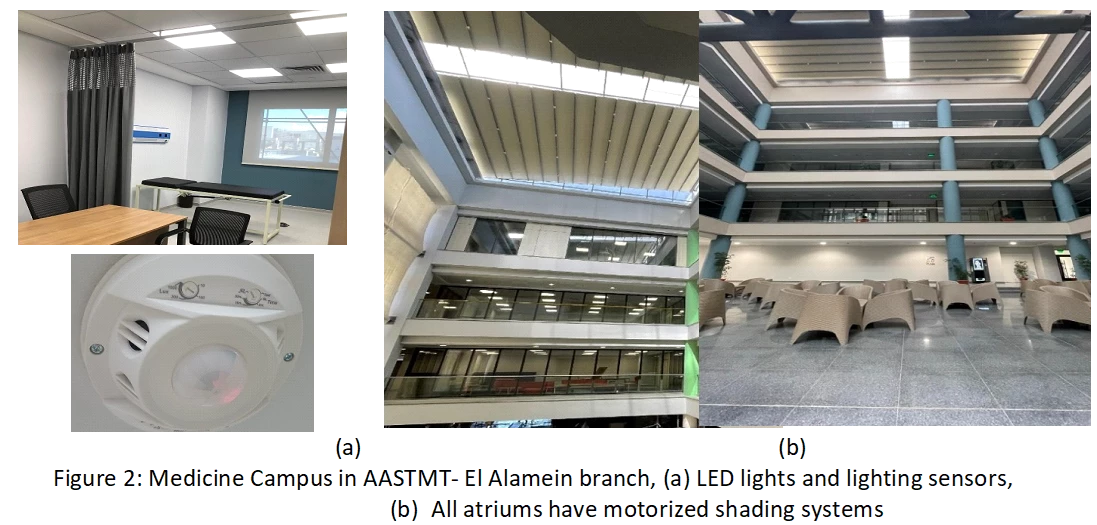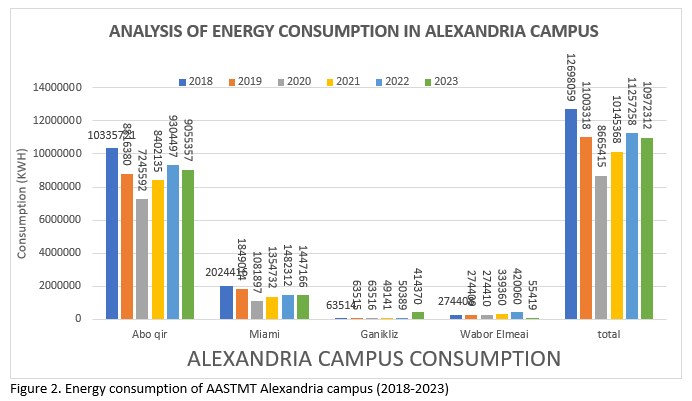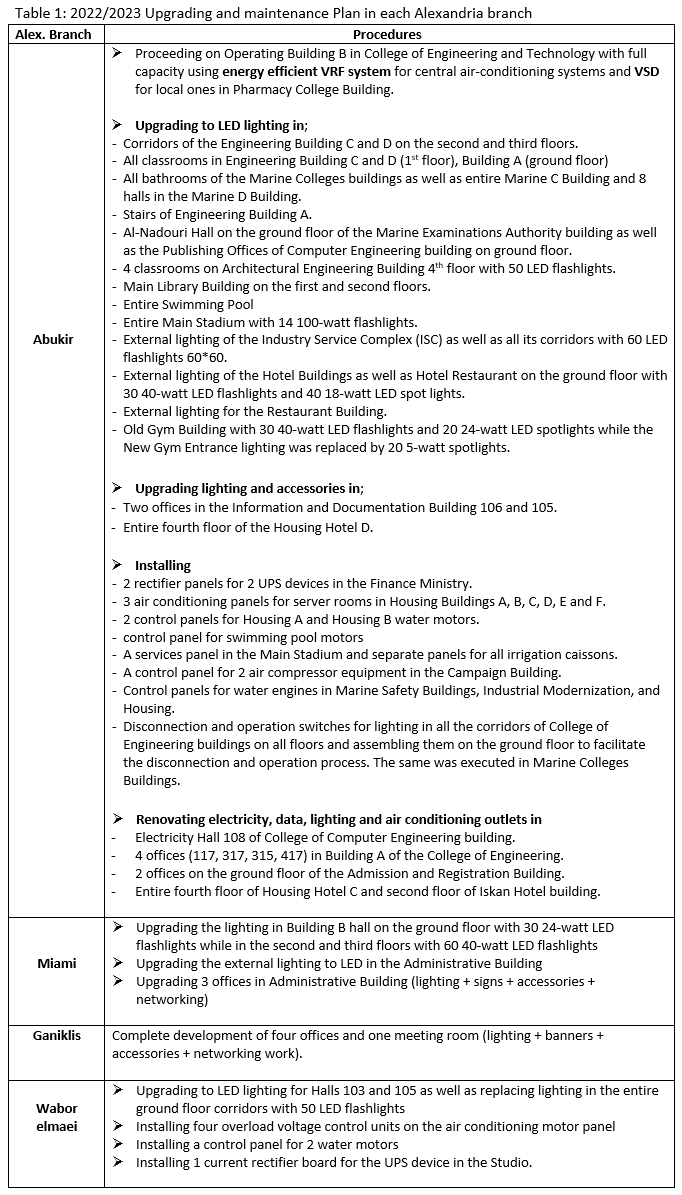To combat high energy usage, AASTMT Energy Research Unit and Energy Management Committee put forward several strategies to reduce and rationalize electrical consumption in AASTMT campuses which primarily include upgrading and renovating existing buildings or establishing new buildings to follow higher energy-efficiency schemes and standards demonstrated in “AASTMT Approach in Establishing, Operating and Maintaining Buildings towards Achieving Sustainable Development Goals at All Academy Headquarters” with the link below.
AASTMT Buildings' Approach towards SDGs-pdf
AASTMT Buildings' Approach towards Achieving SDGs on AASTMT webpage
Each year, AASTMT Energy Research Unit and Energy Management Committee, updates its infrastructure renovation plan to regularly upgrade existing buildings in AASTMT different branches, to higher energy efficiency. This is done primarily to campuses that feature oldest infrastructure and highest energy wastes in order to reduce and rationalize their electrical consumption. Also, in case of new buildings, AASTMT consultancy office make sure that new establishments follow the high efficiency standards. By the end of the year, annual insights of energy consumption in each campus are compared to evaluate university progress towards higher energy efficiency and saving .
Related Annual Plans, Insights and Progress reports can be found in the links below.
AASTMT Annual Energy Plans on AASTMT webpage
AASTMT Annual Insights on AASTMT webpage
AASTMT Annual Energy Progress Reports on AASTMT webpage
AASTMT 2023/2024 Progress Towards Higher Energy Efficiency Buildings
AASTMT 2024 Plan Towards Green Sustainable Energy, included three main aspects (Higher Energy Saving and Efficiency, More Renewable Energy Employment and Less Carbon Emissions). In the first aspect, AASTMT put vast efforts towards enhancing energy efficiency in already existing buildings in different branches, besides establishing new buildings as per high efficiency standards. 2024 energy usage insights validate the effect of these measures in achieving considerable energy saving.
AASTMT 2024 Plan towards Clean Sustainable Energy
AASTMT 2024 Energy and Carbon Insights
AASTMT 2023/2024 Energy Progress Report
2024 Renovations and Upgrading in AASTMT Alex. Branch
In each campus, data from local meters at each building is collected to analyze energy use of this building during different times and identify its subjection to energy wastage or energy inefficiencies. Buildings with highest wastage are to be selected for internal audits and measures are to be taken towards these buildings.
Since AASTMT Alexandria branch features multiple campuses, oldest infrastructure and largest number of staff and students, continuous renovations and upgrading procedures are conducted within its different campuses in 2024 as per the report shown in the following link.
2024 Buildings Upgrading and Energy Conservation Report in AASTMT Alex. Campuses
These renovations include,
First: Abou Qir Branch
- Upgrading lighting at the new gym entrance with 20 spotlights (5 W).
- Upgrading electrical outlets, data points, and lighting on the entire 4th floor of Housing Hotel C.
- Upgrading electrical outlets and accessories on the entire 2nd floor of Housing Hotel E.
- Upgrading lighting in 4 classrooms on the 4th floor of the Architecture Engineering Building with 50 LED fixtures.
- Upgrading lighting in all corridors of Engineering Buildings C and D to LED with 100 fixtures.
- Upgrading lighting in 8 classrooms of Building D (Marine) with 40 LED fixtures.
- Installing 2 power factor correction panels for 2 UPS units in the Financial Affairs Building.
- Installing 2 control panels for water pumps in Housing A and Housing B.
- Upgrading lighting in classrooms on the 3rd and 4th floors of Engineering Building D with 100 LED fixtures.
- Upgrading lighting in classrooms on the 3rd and 4th floors of Engineering Building C with 100 LED fixtures.
- Upgrading all lighting in the main restaurant of Housing Hotel E with 50 LED fixtures.
- Upgrading lighting in 4 classrooms of the Preparatory Studies Building with 60 LED fixtures.
- Upgrading lighting, outlets, and accessories on the 3rd and 4th floors of Housing Hotel C.
- Upgrading lighting, outlets, and accessories on the 1st floor of Housing Hotel D.
- Installing 7 control panels for 7 irrigation system stations.
- Installing 1 power factor correction panel for the Civil Machinery Lab in Engineering Building D.
- Installing 1 power factor correction panel for the paper-cutting machine in the Printing Building.
- Upgrading outdoor lighting at Smart Cafeteria with 6 façade LED lights (100 W).
- Upgrading lighting in the ground-floor classroom of Engineering Building G with 30 LED fixtures.
- Upgrading lighting, outlets, and accessories on the 2nd and 3rd floors of the Industrial Modernization Building.
- Upgrading lighting, outlets, and accessories in Hall 02 of the Preparatory Studies Building.
- Installing 1 power factor correction panel for a UPS device in ground floor of Financial Affairs Building.
- Upgrading outdoor rooftop lighting of Eng. Faculty Buildings with 6 façade LED lights (200 W).
- Upgrading outdoor rooftop lighting of the Maintenance Building with 6 façade LED lights (200 W).
- Upgrading 18 sub-distribution panels (power + lighting) in the Engineering Faculty Buildings.
- Upgrading 6 sub-panels (power + lighting) in Housing Building D.
- Upgrading the main power and lighting panel feeding the restaurant of Housing Hotel D.
- Upgrading 2 panels (power + lighting) feeding the Marine Safety Building vestibule.
- Upgrading the hangar power and lighting panel of the Technicians’ Building.
- Upgrading the Maintenance Building’s power and lighting panel.
- Upgrading all 2nd floor offices of Engineering Building A (lighting + outlets + accessories).
- Upgrading 4 classrooms on the 2nd, 3rd, and 4th floors of the Computers Faculty (lighting + outlets + accessories).
- Upgrading corridor lighting throughout Engineering Building G with 300 LED fixtures.
- Upgrading lighting in 4 classrooms of Engineering Building G with 60 LED fixtures.
- Upgrading lighting in 6 classrooms of the IMO Building with 80 LED fixtures.
- Installing 2 control panels for irrigation pumps of the main field and restaurant, each 3 HP.
- Upgrading pool lighting in the Marine Safety Building with 4 façade LED lights (200 W).
- Upgrading the second phase of low-voltage panels at the main distribution station.
- Upgrading room lighting in Housing A and Housing B with 180 LED fixtures.
- Upgrading bathroom lighting in Housing A and B with 60 LED spotlights.
- Installing a service panel at the Engineering Faculty field for temporary electrical connections during events.
- Upgrading 2 control panels for the water desalination plant at the main restaurant.
- Upgrading the fire alarm panel in the Admissions and Registration Building.
- Installing a power factor correction panel for a UPS in the ground floor of the Financial Affairs Building.
- Installing an alternating control panel for water pumps in Engineering Building G.
Second: Miami Branch
- Upgrading lighting on the ground floor of the main library and Building A classrooms with 50 LED fixtures (40 W).
- Upgrading rooftop lighting of Buildings A and C to LED with 6 façade fixtures (200 W).
- Upgrading 6 administrative offices on the ground floor of Building A (lighting + outlets + accessories).
- Upgrading 3 classrooms on the 3rd floor of the Administrative Building (lighting + outlets + accessories).
- Upgrading lighting in 4 classrooms of Building A with 40 LED fixtures.
- Upgrading outdoor lighting of the Administrative Building and Building B with 40 spotlights (6 W).
- Upgrading landscape lighting with 20 lighting poles.
- Installing a service panel at the International School playground for event and occasion power connections.
- Upgrading interior lighting of the new gym.
- Installing a separate power panel for the new gym.
Third: Wabour El-Maya Branch
- Upgrading corridor lighting on the ground floor to LED with 50 fixtures.
- Installing 1 power factor correction panel for a UPS in the Studio.
- Upgrading corridor lighting on the ground floor to LED with 50 fixtures (duplicate task confirmed).
- Installing 1 control panel for 2 water pumps (3 HP).
- Upgrading lighting in 6 classrooms with 50 fixtures.
- Upgrading lighting in ground-floor corridors and 8 classrooms with 50 spotlights (24 W).
- Upgrading lighting in classrooms and corridors on the 1st and 2nd floors with 30 spotlights (24 W).
These renewal, upgrading, and control efforts in different campuses of AASTMT Alexandria branch have resulted in total electricity savings in 2024 of 474,289 kWh from 2023 as shown in Table 1 and given by 2024 Energy Conservation Report. This verifies the effectiveness of AASTMT plan and measures towards energy efficiency and saving in its entire Alexandria campuses in 2024.
2024 Buildings Upgrading and Energy Conservation Report in AASTMT Alex. Campuses
Table1: Electrical Energy Savings in 2024 in AASTMT Alexandria Campuses
|
Year
|
Lighting (LED) Savings
|
Irrigation Savings
|
Air Conditioning
Savings
|
Motors and Equipment Savings
|
Total Savings
|
|
2024
|
124,816 kWh
|
124,816 kWh
|
144,420 kWh
|
80,237 kWh
|
474,289 kWh
|
For further validation to annual energy saving efforts in AASTMT-Alex. campuses, Fig. 1 shows energy usage in Alex. Campuses from 2022 till 2024. It is clear that following the yearly renovation and modernization measures planned for different AASTMT Alexandria buildings, notable energy savings are achieved in 2023 by 2.5% from 2022 resulting in energy usage of 10,972,312 kWh and a further significant decrease in 2024 by 4.32% from 2023, achieving energy consumption of 10,498,097 kWh

Figure 1. Electrical Energy consumption in kWh of AASTMT Alexandria campus (2022-2024)
2024 New Energy-Efficient Buildings Establishments in AASTMT- Alamein Campus
In AASTMT-Alamein branch, the installation of College of Medicine has been finished in 2024. Thermal characteristics of walls, glasses and roofs have a strong impact on the cooling load and chilled water demand of a building. To obtain a properly sized and energy-efficient cooling system, a thermal efficient building shell is utilized in the design with the following specifications:
- Maximize light colors for roofing and wall finishes materials.
- Install high R-value wall and ceiling insulations.
- Use minimum glass on east and west exposures.
- Use windows with low shading coefficient (SC) such as double glass windows and roof, however with shaded curtains.
- Minimizing electrical loads from lighting by using light sensors to benefit from natural lighting as much as possible during day-time.
- Implementing recommended lighting intensity as per ASHRAE 90.1-2007 and also LED luminaries to minimize heat built up.
Since dependence on natural lighting is a main goal to reduce electrical load, a transparent glass roof is used. However, this would increase the indoor temperature and affect the AC conditioner efficiency. Thus, motorized shading systems -curtains that can be opened or closed based on sunlight intensity, room temperature, or time of day - are implemented for automatic adjustment for optimal cooling, thus enhancing energy efficiency as follows,
- During hot hours, they are closed to block solar radiation preventing rooms from heating up (Up to 30–40% reduction in unwanted heat gain). Thus, AC works less while maintaining a comfortable temperature. When less heat enters the room, the AC runs for shorter cycles and at lower power, thus improving its cooling efficiency, extending its lifespan and reducing maintenance needs. This can reduce AC energy use by 10–25%.
- On cool days, they open to allow natural light, ventilation and reduce lighting and energy consumption.

AASTMT 2022/2023 Plan Towards Green Sustainable Energy
AASTMT AASTMT 2022/2023 Plan towards Clean Sustainable Energy, included four main aspects (Towards Energy Saving, Higher Energy Efficiency, Renewable Energy Employment and Carbon Emissions Reduction). Analyzing AASTMT energy consumption insights in AASTMT 2022/2023 Insights, for different AASTMT campuses as shown in Figure 1, it was found that Alexandria campus (oldest, largest and highest students and staff number among all AASTMT campuses), consume highest energy in 2022. Hence, as per the Higher Energy Efficiency aspect in 2022/2023, the renovation measures primarily focused on different Alexandria campus covering its different branches.

2022/2023 Renovations in AAST Alexandria campus -different branches (Abukir, Miami, Ganaklis, Wabour Elmaei) include;
- Completing the replacement of lighting lamps and working with LED lamps as was planned for 2022/2023, where replacement rate rises to more than 95% leading to a significant reduction in electricity consumption.
- Applying motion-sensor lighting in common areas.
- Increasing the operating efficiency of many air-conditioning systems (energy-efficient HVAC systems)
- Regular electrical maintenance procedures.
- The university fully utilized it photovoltaic infrastructure in 2022 where a solar power station with a capacity of 50 kilowatts is installed in the 7th Engineering Building in Alexandria campus- Abukir branch.
- Solar heaters have been installed to replace the electric heaters in students’ dorms – Alexandria campus- Abukir branch as planned in 2022, besides the already applied ones in the Pharmacy college.
Noting that detailed renovations and maintenance procedures in each Alexandria branch with each building number are listed separately at the end of this discussion;
Besides, energy saving procedures discussed in details in AASTMT 2022/2023 Plan towards Clean Sustainable Energy, different building renovations in all branches of AAST Alexandria campus, to include energy-efficient technologies, contributed in overall 13.6% reduction in electricity use in 2023 compared to 2018 levels and 2.5% reduction compared to 2022 levels as shown in Figure 2. Note that, the lowest load was in 2020 during Covid 19, then it gradually increased until all the branches returned to their full load in 2022. That’s why for fair, 2023 energy consumption is compared to that of 2018 (full operation before Covid) and 2022 (full operation after Covid). This is demonstrated in details in 2022/2023 Insights Report.
This reduction in energy consumption reflects AASTMT successful progress towards higher energy efficiency as demonstrated in AASTMT 2022/2023 Energy Progress Report .

2022/2023 Detailed Renovations and Maintenance procedures in Alexandria campus
Detailed renovations and maintenance procedures, in Alexandria different branches (Abukir, Miami, Ganaklis, Wabour elmaei) are detailed in AASTMT 2022/2023 Plan towards Clean Sustainable Energy, stating each building number and renovation procedure as summarized in Table 1.



